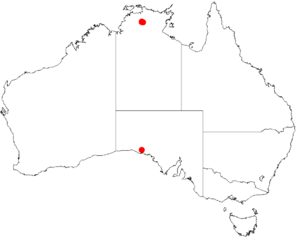Acacia amanda facts for kids
Quick facts for kids Acacia amanda |
|
|---|---|
| Conservation status | |
|
NT (TPWCA)
|
|
| Scientific classification | |
| Genus: |
Acacia
|
| Species: |
amanda
|
 |
|
| Occurrence data from AVH | |
| Synonyms | |
|
Racosperma amanda (G.J.Leach) Pedley |
|
Acacia amanda is a type of shrub that belongs to the Acacia plant family. It grows naturally in the Northern Territory of Australia. This plant is a special kind of wattle, known for its unique features.
Contents
About the Acacia amanda Plant
Acacia amanda is a shrub that often grows straight up. It can have many stems and usually reaches a height of 0.4 to 2 meters (about 1.3 to 6.5 feet). Its branches are smooth and have a slightly waxy coating.
The leaves of this plant are not typical leaves. They are called phyllodes. These are flattened leaf stems that look and act like leaves. The phyllodes of Acacia amanda are a dull grey-green color. They are shaped like a narrow oval, either straight or slightly curved. Each phyllode is about 38 to 124 millimeters (1.5 to 4.9 inches) long and 8 to 36 millimeters (0.3 to 1.4 inches) wide. They have three main veins that run along them.
When Acacia amanda flowers, it produces beautiful golden, round flower heads. Each head has between 35 and 53 tiny flowers. These flowers grow on stalks called peduncles, which are 15 to 35 millimeters long. Sometimes, the flowers grow in a long cluster called a raceme, which can be 75 to 180 millimeters long. Each flower has five parts, and its sepals (the leaf-like parts that protect the bud) are separate.
After flowering, the plant produces narrow seed pods. These pods are straight and measure 42 to 110 millimeters (1.7 to 4.3 inches) long and 7 to 13 millimeters (0.3 to 0.5 inches) wide. They are thin and feel like paper. Inside, the seeds are dark brown or black, about 6 to 7.5 millimeters long. They do not have an aril, which is a fleshy covering found on some seeds.
You can find Acacia amanda growing along seasonal creek lines. It also grows on clay flats that are located downstream from the Koolpin gorge. This plant usually blooms from May to November.
How Acacia amanda Got Its Name
The first scientific description of Acacia amanda was made by a botanist named Gregory John Leach in 2001. A botanist is a scientist who studies plants.
Later, in 2003, the plant was placed into a different group called Racosperma amanda. However, scientists decided in 2006 to move it back to the Acacia group, where it remains today. This process of moving a species between different scientific groups is called reclassification.
Where Acacia amanda Lives
Acacia amanda is endemic to a very specific area. This means it is found only in that one place and nowhere else in the world. It lives on the Arnhem Plateau, which is located inside Kakadu National Park in the Northern Territory.
Meaning of the Name Amanda
The specific name amanda comes from the first name of the wife of the botanist who first described the species, Gregory John Leach.

